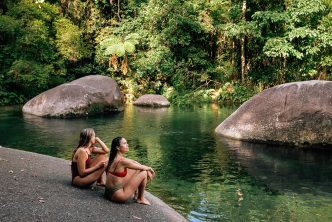There are two kinds of people in this world: those who will travel to the ends of the earth to discover the greatest scuba diving sites, and those who haven’t yet realised they should. We’re in the former.
There’s nothing quite like pulling on your dive mask, fins and regulator and taking a peek beneath the water’s surface. It’s strange yet familiar, peaceful but also an adrenalin rush. It takes you outside your daily comfort zone and reveals a hidden world that not many others ever get to witness.
Our friends from personalised dive travel agency Diveplanit Travel recently compiled a list of the top scuba diving sites in Queensland. From exclusive island hideaways to remote and untouched coral reefs, there’s something for every interest and skill level.
See if you agree with the list.
Ribbon Reefs and the Coral Sea
The pristine and rarely visited Ribbon Reefs are among the greatest dive sites in Queensland (and the world). Away from the tourist trail, these remote sites can be experienced with liveaboard operator, such as the amazing Mike Ball Dive Expeditions. They have four new itineraries visiting the Ribbon Reefs, Cod Hole, and in the Coral Sea, Osprey Reed (aka shark city) and Bougainville Reefs. Choose from an easy 4 or 5-night escape, or take it to the next level with a 7-night exploratory trip.

Cairns
Cairns is the jump off point to countess incredible sites. Though day trips are a great way for the time poor, a liveaboard boat trip is the best way to fully experience them. Pro Dive Cairns runs 3 Day/2 Night liveaboard trips to the Outer Reef each week every Wednesday and Friday. The trips include up to 11 dives, including two-night dives, on a variety of 19 dive sites over four reefs: Flynn, Thetford, Milln and Pellowe Reefs. You will encounter a wide diversity of marine life including giant clams, turtles, stingrays, reef sharks, a rainbow of tropical fish, and spectacular coral formations.

Townsville and Magnetic Island
The Central Great Barrier Reef has long played second fiddle to the better-known reefs out from Cairns and Port Douglas, but it’s finally getting its well-deserved moment in the spotlight. The 100-year old wreck of the Yongala and the new Museum of Underwater Art installation by world-famous sculptor Jason deCaires Taylor are genuine bucket list dive sites. You can dive them by liveaboard with Adrenalin Dive, with Yongala Dive, or base yourself on beautiful Magnetic Island.

Heron Island
Heron Island in the Southern Great Barrier Reef, reached by helicopter or ferry from Gladstone, is renowned for its spectacular coral reef and is a sanctuary for a dazzling variety of marine life. Accommodation options range from rooms set amongst a leafy forest, to beachside rooms with immediate access to crystal clear waters teeming with nesting turtles, reef fish, turtles, rays, reef sharks and more. There are 20 nearby dive sites accessible by boat within minutes of the jetty.

Lady Elliot Island
Lady Elliot Island is one of those rare gems. The island is just 10 km from the edge of the continental shelf and the East Australian Current, which means frequent pelagic action such as manta rays and migrating whales. It’s also a vital nesting ground for green and loggerhead turtles. Lady Elliot sits within the Green Zone of the Great Barrier Reef Marine Park, which is why the corals are in such perfect condition. Over 1,000 marine species can be found in the waters around the island.

Lady Musgrave Island
Just like Lady Elliot, Lady Musgrave Island is close to the continental shelf, meaning it attracts impressive pelagic species such as leopard sharks, reef sharks, turtles, and all sorts of rays including mantas. It also gets the occasional migrating humpback whale. The wreck of the HMAS Tobruk in the nearby Bundaberg region, your jump-off point for Lady Musgrave, was only scuttled a couple of years ago but has already attracted large schools of Jacks, barracuda, bat fish, and Queensland gropers.

Want to organise an unforgettable Queensland dive holiday? Check out diveplanit.com



















Beautiful photographs ?